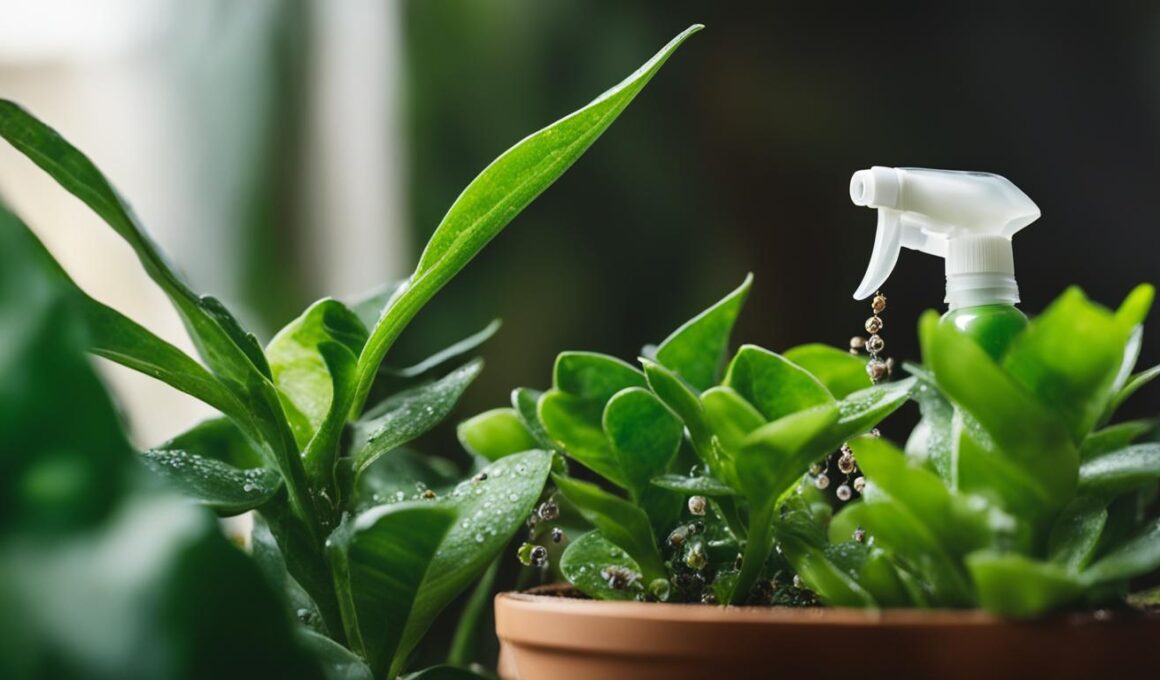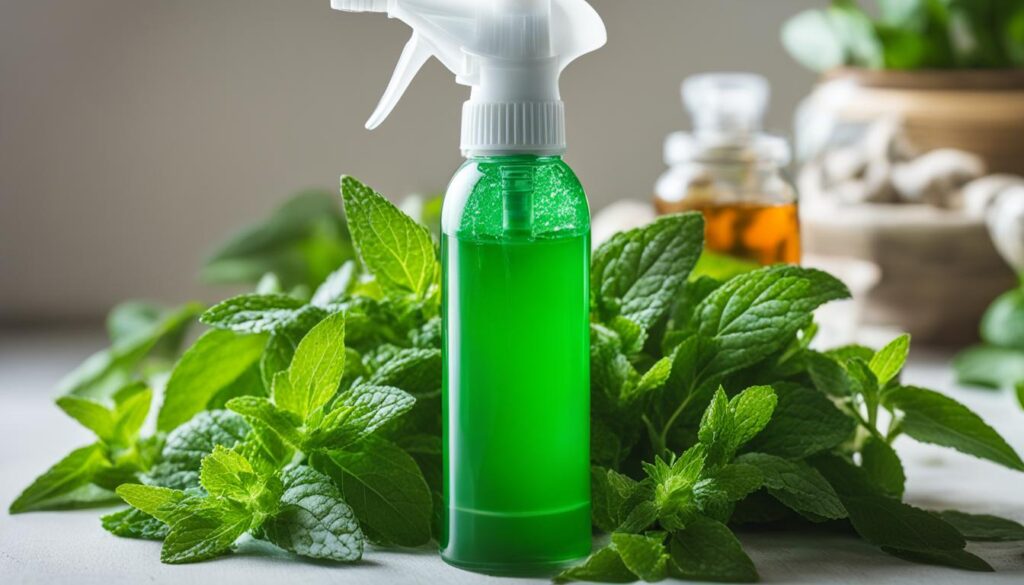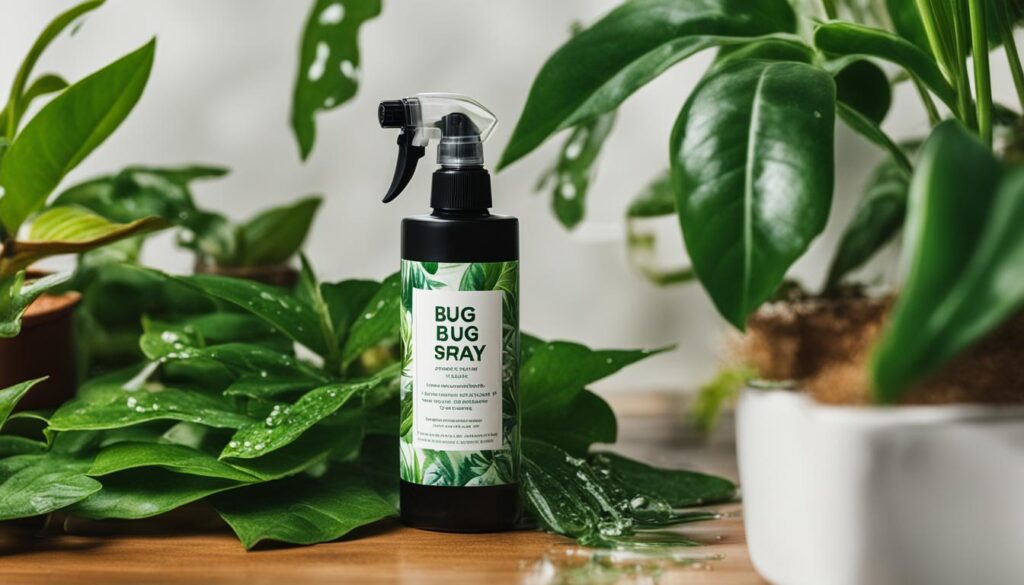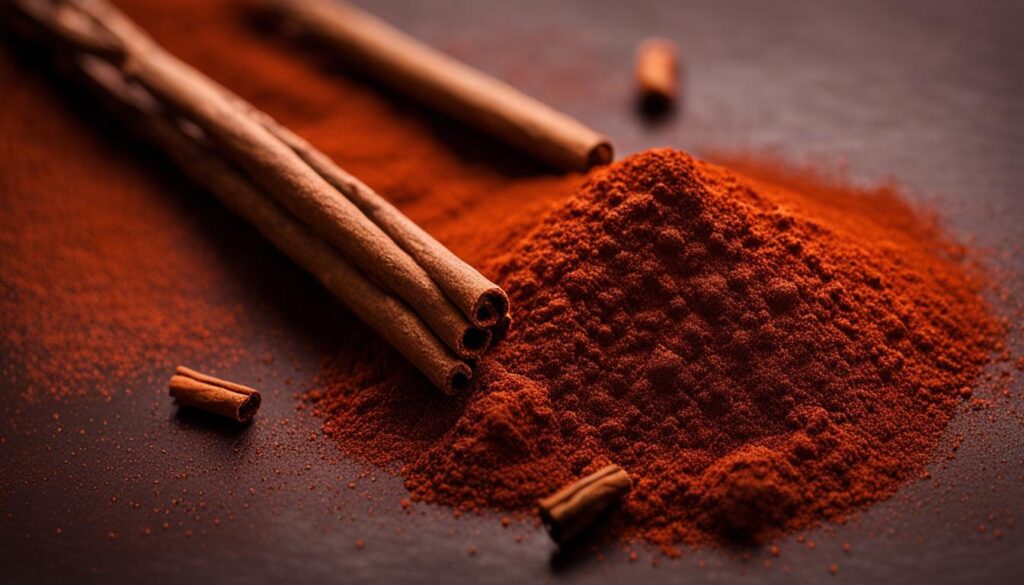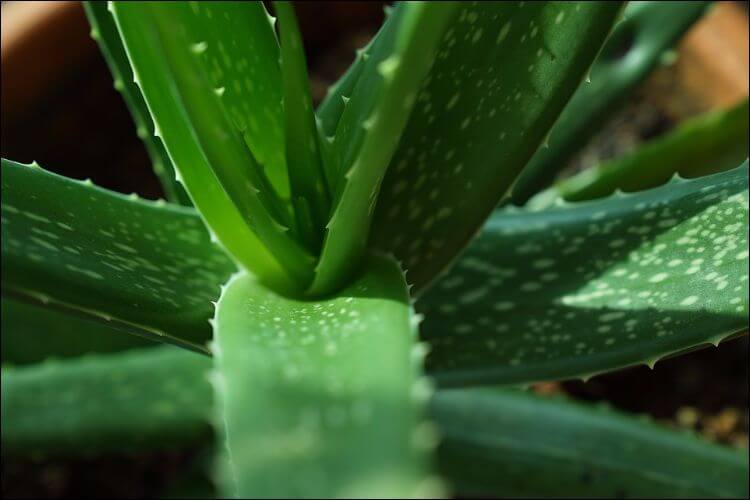Dealing with pests in houseplants can be a common issue for plant parents. The thought of using toxic chemicals indoors can be concerning, especially for those with pets and children. However, there are safe and effective homemade bug sprays that can be used to keep your houseplants pest-free. In this article, we will explore natural ingredients and DIY recipes for house plants bug spray that are both safe and effective.
Key Takeaways:
- House plants bug spray is a safe and effective way to control pests in your indoor greenery.
- Using homemade bug sprays made from natural ingredients can help avoid the use of toxic chemicals.
- Dishwashing liquid or castile soap, cinnamon, and vegetable oil are common household ingredients that can be used to make homemade bug sprays.
- Each ingredient has specific properties that make it effective in controlling different types of pests.
- Experiment with different recipes to find the ones that work best for your specific pest problems.
Common Household Ingredients for Homemade Bug Spray
When it comes to keeping your houseplants pest-free, you don’t always have to rely on store-bought chemicals. In fact, there are several common household ingredients that can be used to create homemade bug sprays that are both safe and effective. These simple DIY solutions can help protect your plants from pests without the worry of exposing your family and pets to harmful toxins.
Household Ingredients for Homemade Bug Spray:
- Dishwashing liquid or castile soap: Soap-based sprays suffocate pests like spider mites, mealybugs, and aphids. Use a 1 tsp soap to 1 liter water ratio and spray every 4 to 7 days.
- Cinnamon: Sprinkling ground cinnamon on the top layer of soil helps deter fungus gnats and prevent fungal growth.
- Vegetable oil: Oils like canola oil can be mixed with dishwashing liquid and water to create a spray that effectively controls sap-sucking pests like aphids and scale.
- Diatomaceous earth: This powdery substance is abrasive to insects and can be sprinkled on plant foliage or applied to the soil to control pests.
- Chili and garlic spray: A homemade spray made from chili peppers and garlic cloves can be used to repel pests like aphids, whiteflies, and caterpillars.
- Khakibos or tomato leaves: Both of these natural ingredients can be steeped in water to create a potent pest-repellent spray.
By using these household ingredients, you can create effective bug sprays that are safe for your houseplants and the environment. Experiment with different recipes to find the ones that work best for your specific pest problems, and enjoy a pest-free indoor garden.
Using Dishwashing Liquid or Castile Soap as a Bug Spray
Dishwashing liquid or castile soap is a common household ingredient that can be used as a bug spray for houseplants. The soapy residue suffocates pests like spider mites, mealybugs, and aphids while also deterring them from eating the plant. It is important to use the correct soap-to-water ratio to avoid damaging the leaves. A basic recipe for using soap as a pesticide is to mix 1 tsp of dishwashing liquid or castile soap with 1 liter of water and spray the solution on your houseplants every 4 to 7 days.
This homemade bug spray is effective in controlling pests without the use of toxic chemicals, making it safe for your family and pets. It is a natural and affordable solution that can be easily made at home. The soapy solution works by coating the pests’ bodies, causing them to suffocate and die. Additionally, it acts as a deterrent, preventing pests from returning to your plants. Regular application of the soap spray can help keep your houseplants healthy and pest-free.
“Using dishwashing liquid or castile soap as a bug spray for houseplants is a safe and effective method to control pests. It is important to use the correct ratio of soap to water to avoid damaging the leaves. Regular application of the soap spray can help keep your houseplants healthy and pest-free.”
To apply the soap spray, simply fill a spray bottle with the soap-water mixture and thoroughly coat both sides of the leaves, including the stems. Pay extra attention to areas where pests are commonly found, such as the undersides of leaves and leaf joints. It is recommended to apply the spray in the early morning or late evening when the sun is not too strong, as it may cause the leaves to burn. Remember to reapply the soap spray every few days to ensure continuous pest control.
By using dishwashing liquid or castile soap as a bug spray for your houseplants, you can effectively protect your greenery from pests while maintaining a safe and chemical-free environment. This natural pest control method is easy to make and can be an excellent alternative to commercial insecticides. Keep your plants healthy and thriving with this homemade pesticide.
Using Cinnamon as a Natural Pest Control
When it comes to protecting your houseplants from pests, cinnamon can be a powerful ally. Its natural properties make it an effective and safe homemade bug spray, particularly for deterring fungus gnats. With its antibacterial and antifungal qualities, cinnamon helps prevent fungal growth in potting soil, which is a common breeding ground for these annoying pests.
To use cinnamon as a natural pest control, simply sprinkle ground cinnamon on the top layer of soil around your plants. This will help dry out the soil, creating an unsuitable environment for fungus gnats to thrive. Don’t forget to cover both the top and bottom of the leaves with cinnamon to ensure thorough protection.
“Cinnamon has been a game-changer for my indoor plants. Not only does it keep the fungus gnats away, but it also adds a pleasant scent to my home.” – Plant Enthusiast
Using cinnamon as a natural pest control method not only helps safeguard your greenery but also provides a chemical-free alternative to toxic pesticides. It’s a simple and affordable solution that can be easily incorporated into your plant care routine.
Benefits of Using Cinnamon as a Natural Pest Control:
- Antibacterial and antifungal properties prevent fungal growth in potting soil
- Deters fungus gnats and other pests from infesting your houseplants
- Safe and chemical-free alternative to toxic pesticides
- Pleasant aroma adds a natural fragrance to your home
Try using cinnamon as a natural pest control method for your houseplants and enjoy the benefits of a pest-free indoor environment and thriving greenery. It’s an eco-friendly and effective solution that will keep your plants healthy and happy.
Using Vegetable Oil as a Pest Control
When it comes to keeping pesky pests like aphids and scale at bay, vegetable oil can be a valuable tool in your homemade pest control arsenal. Vegetable oils, particularly canola oil, possess insecticidal properties that can effectively combat these sap-sucking insects. By blocking the air holes through which insects breathe, oils can lead to their asphyxiation. Additionally, the interaction between vegetable oils and the fatty acids in an insect’s body can disrupt its normal metabolism, further contributing to their demise.
To create a homemade pesticide using vegetable oil, you’ll need a few simple ingredients. In a spray bottle, mix 2 tablespoons of dishwashing liquid, ½ cup of vegetable oil, and water. Dilute the mixture with water and shake well. Now, you’re ready to spray the solution on your infected plants, ensuring thorough coverage of both the top and bottom of the leaves. The suffocating effect of the oil will help rid your houseplants of aphids and scale, restoring their health and vitality.
Benefits of Using Vegetable Oil:
- Effective against sap-sucking pests like aphids and scale.
- Blocks air holes to cause asphyxiation.
- Disrupts the insects’ metabolism.
- Does not require the use of toxic chemicals.
- Safe for indoor use, even with pets and children present.
“Using vegetable oil as a pest control method has been a game-changer for my houseplants. It’s a natural and safe way to combat aphids and scale without exposing my family and pets to harmful chemicals. Plus, it’s incredibly easy to mix up the solution and apply it to my plants. I highly recommend giving it a try!” – Plant Parent
Conclusion
Protecting your houseplants from pests is essential for their health and longevity. Homemade bug sprays using common household ingredients can provide a safe and effective method to control pests without resorting to toxic chemicals. By utilizing ingredients like dishwashing liquid, cinnamon, and vegetable oil, you can safeguard your greenery and maintain a pest-free indoor environment.
These natural and do-it-yourself bug spray solutions offer a healthier and happier alternative for your indoor plants. Experiment with different recipes to find the ones that work best for your specific pest problems. Embrace the power of homemade pest control and protect your greenery with confidence.
With house plants bug spray made from everyday items, you can easily create an effective defense against pests. These safe and natural methods not only keep your plants healthy, but also ensure the well-being of your pets and children by avoiding harmful chemicals. Say goodbye to unwanted invaders and hello to thriving indoor plants with homemade bug sprays.
Can I Use the House Plants Bug Spray Outdoors as Well?
Yes, you can use natural bug repellent plants bug spray outdoors as well. Many common house plants like lavender, citronella, and mint can be effective at repelling insects when used as a spray. Simply mix the plants with water and apply to outdoor areas to help keep bugs at bay.
FAQ
Can homemade bug sprays be as effective as commercial ones?
Yes, homemade bug sprays can be just as effective in controlling pests in houseplants. By using natural ingredients with specific properties, you can safely and effectively keep your plants pest-free.
Can I use dishwashing liquid as a bug spray for my houseplants?
Yes, dishwashing liquid or castile soap can be used as a bug spray for houseplants. The soapy residue suffocates pests like spider mites, mealybugs, and aphids while also deterring them from eating the plant.
How often should I spray my houseplants with dishwashing liquid solution?
It is recommended to spray your houseplants with dishwashing liquid or castile soap solution every 4 to 7 days to effectively control pests. Make sure to follow the correct soap-to-water ratio to avoid damaging the leaves.
Can cinnamon help control fungus gnats in houseplants?
Yes, cinnamon can be an effective natural pest control for fungus gnats in houseplants. Its antibacterial and antifungal properties help prevent fungal growth in potting soil, which is a common breeding ground for fungus gnats.
How do I use cinnamon as a pest control for my houseplants?
Sprinkle ground cinnamon on the top layer of soil to help dry it out and create an unsuitable environment for fungus gnats. It’s important to cover both the top and bottom of the leaves with cinnamon to ensure thorough protection.
Can vegetable oil be used as a pest control for aphids?
Yes, vegetable oil, especially canola oil, can be used as a natural pest control for sap-sucking pests like aphids. Oils block the air holes through which insects breathe, causing asphyxiation and disrupting their normal metabolism.
How do I use vegetable oil as a pest control for my houseplants?
Mix 2 tablespoons of dishwashing liquid, ½ cup of vegetable oil, and water in a spray bottle. Dilute the mixture with water and spray it on your infected plants to effectively control pests like aphids and scale.
Are homemade bug sprays safe for my pets and children?
Homemade bug sprays using common household ingredients are generally safe for pets and children, as they do not contain toxic chemicals. However, it’s always best to keep pets and children away from sprayed plants until the solution has dried.
How often should I use homemade bug spray on my houseplants?
The frequency of using homemade bug spray will depend on the severity of the pest infestation. It is generally recommended to spray your houseplants every few days to once a week, monitoring the effectiveness and adjusting as needed.





